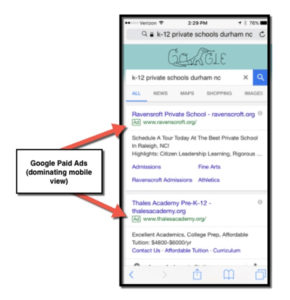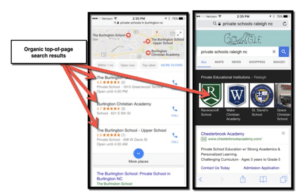Need to Boost Enrollment? 7 Powerful Reasons to Harness Google Search
Most school leaders need to find ways to boost enrollment. This is why I am excited about the webinar I am offering on Thursday, March 9, at 1pm EST. The North Star Marketing team will be presenting a webinar on “How Changes in Google Search Results are Impacting Your Enrollment.” You can still register for this webinar and it will be recorded if you can’t attend live.
As a way to prepare for this webinar, I asked the team at North Star Marketing (Andy Lynch, Clark Morgan and Kaleen Goodeill) to write a guest blog post on this topic. In this post, they discuss seven powerful reasons to harness Google search as a way to boost enrollment in your school. You’ll hear from this same team in the webinar on Thursday.
The pressing question
If you’ve ever found yourself staring at a spreadsheet, puzzling over your school’s marketing strategy and budget, you’re in good company. This scenario plays out over and over every year in marketing and admission offices around the world. The overarching question is a simple one, yet the implications are massive: “How do I best use our school’s limited marketing dollars?”
In answering that question, many marketing and admission directors are shifting more resources towards online marketing. And rightly so, as parents turn to the web for answers to most of life’s questions. But the world of digital advertising is so broad and so nuanced that piecing together a strategy can be a daunting task. And the last thing you want to do is squander your school’s limited marketing budget.
As with most questions, turn to Google for answers
Like the parents you’re targeting, turn to Google for answers. In this case, we don’t necessarily mean you should Google the question, “How do I best use our school’s limited marketing dollars?” Rather, before you invest in any other form of paid media (e.g. direct mail, radio, TV, billboards, newspaper, etc.), be sure you’ve positioned your school’s brand to be highly visible on Google, which is where parents go to learn about, research, and form opinions of their education options. Yes, there are plenty of other places to show up online, such as Facebook, GreatSchools.com, etc., but all others trail behind Google.
When a parent types in a keyword or phrase in the Google Search bar, the results include both the paid and organic search results, factoring in the geographic location in which the parent performed the search. The paid search results include ads that can occupy the top four page positions on Google, as well the last three spots at the very bottom of the search results page. On a mobile phone, these paid ads can take up nearly the entire screen. Per the name, you must pay for these ads to show up on Google.

Organic search results encompass all the free search results your school can earn, including Google’s local map results (also called the “Local 3-Pack”), Knowledge Panel, and Carousel. While there is still a cost incurred to “earn” these listings (e.g., people/time/money), you don’t pay Google anything for organic search results to appear.

Now that we’ve identified where your school could show up in a Google search, let’s dig a bit deeper into why an investment in Google Search likely makes sense for your private school’s marketing strategy.
Reason #1 – Your prospects are searching on Google
While this notion may seem obvious, understanding the data behind it is helpful. According to a recent 2016 report in the Search Engine Journal, Google now controls over 85 percent of the U.S. search market, and that number doesn’t appear to be slowing down. When it comes to mobile search in the U.S., that number can surge to over 90 percent. This data reveals something certain: Families researching education options are using Google. If your private school doesn’t have top-page visibility on Google (via paid and organic search channels), you’re missing a tremendous opportunity to drive prospective parents to your website.
Reason #2 – Target your audience with laser precision
By leveraging both paid and organic search results on Google, schools can pinpoint their target audience within tightly defined geographic areas. Google paid search allows you to include or exclude specific cities or zip codes, triggering ads based on a clear set of keywords you know your audience is searching for (e.g., private schools in “your city”). Through organic search engine optimization (SEO) you can help ensure your school accurately shows up in free listings such as Google’s local map results, as well as other organic listings below the local 3-pack map results.
Reason #3 – Gain instant top-of-page visibility with Paid Search and long-term credibility through Organic Search
One of the primary advantages of paid search on Google is instant visibility. With paid search, as soon as your campaign goes live, prospects will see your ads at the top of the search results page. Ads showing in positions 1-3 are the most likely to be seen and clicked on by searchers. Bear in mind paid search is not free, and your competitors are likely interested in keywords that are important to you. But sitting on the sidelines means you are conceding valuable clicks to neighboring schools.
While boosting organic visibility takes more time, many users tend to view “natural rankings” as a sign of authenticity. The thinking goes something like this: “A school that has achieved high organic rankings is doing a better job of earning my business than a school that has paid for my attention.” Although this thinking is flawed, it’s common. There are several key steps you can take to gain top-of-page organic listings: Optimizing your Google My Business listing, garnering positive reviews, and using best practice on-page SEO.
Reason #4 – Get immediate traffic and leads
When you need new leads and need them quickly, paid search on Google can be similar to turning on the faucet. With ads seen instantly, schools can gain more real estate on page one of Google. This helps capture more active prospects who are currently exploring new education options for their children. Paid search can also be powerful during enrollment season when online searches for local private schools are at an all-time high. Google Search is much like the game of Monopoly. The more real estate you own on page one (through both paid and organic search results), the higher the probability that prospects will click on your listing and arrive at your school’s website. Be advised; there will likely be a “truing up” season in which your refine your campaigns to generate higher quality leads.
Reason #5 – Visibility in cities outside your physical location
With changes to Google’s algorithm over recent years, showing up in the cities outside your school’s physical location has become more challenging, yet ever more important as many parents are willing to drive to a neighboring city for a preferred school. As you may expect, schools tend to show up better on Google searches in the cities/towns in which they operate. However, Google’s paid search platform can provide visibility for your school in areas outside your school’s physical location. When setting up your Google AdWords campaign, choose the target geographies where you want to show your ads. From there, any prospects who are searching for private schools in nearby towns will immediately see your ads.
Reason #6 – Increase brand awareness
Awareness is critical for your school. A family won’t choose you if they’re not aware of you. Google plays a significant role in bringing visibility to your school. Regardless of whether your target audience sees paid results or organic search results, they still encounter your brand when searching on Google. This visibility means more exposure for your school. Even when your school shows up on Google alongside competitors, prospects may pay extra attention to your brand during a critical phase of their search process. You need to be there when they are searching!
Reason #7 – Measurable return on investment (ROI)
You can’t improve what you can’t measure. One major advantage of Google Search is that it’s easy to measure success and track your return on investment. By installing Google Analytics on your website, along with some simple javascript on your web forms (your website developer can help with these small projects), you can instantly measure the sources driving your web traffic and leads. Understanding what marketing channels your leads are coming from and tracking them in your customer relationship management software (or a spreadsheet) will help tie enrollments back to their point of origin. Marketing team members can then look at online marketing initiatives to determine what kind of return on investment they’re getting. This determination helps inform online marketing improvements and guide decisions about your future marketing budget.
So, as you tighten up that planning spreadsheet, be sure to make plenty of room for Google, both in time allocation and budget. When planned and managed correctly, Google Search can prove to be a top source that drives traffic and leads to boost enrollment at your school.
To learn more about Google Search, visit www.northstarmarketing.com.
FREE WEBINAR: How Changes in Google Search Results Are Impacting Your Enrollment
Hosted by Enrollment Coach Dr. Rick Newberry and North Star Marketing


